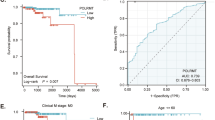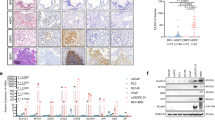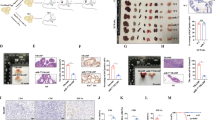Abstract
In this study, we have taken advantage of over-expression of eukaryotic translation initiation factor 4E (eIF4E) in prostate cancer cells to design a viral-based targeting system of prostate cancer. Three different lengths of 5′-untranslated regions (5′UTRs) derived from either fibroblast growth factor-2 (FU-FGF2-GW) or ornithine decarboxylase (FU-ODC149-GW and FU-ODC274-GW) were inserted upstream of enhanced green fluorescent protein (GFP) gene in a lentiviral backbone. Both nonmalignant control (PNT1B and BPH-1) and neoplastic (LNCaP, C4-2, DU145 and PC-3) prostate cell lines were transfected with each plasmid or virus alone, or in the presence of siRNA against eIF4E, and their expression was monitored via GFP protein levels. Two 5′UTRs (FU-FGF2-GW and FU-ODC-GW) were selected as being most sensitive to eIF4E status. Lentiviruses containing these sequences were injected directly into the prostates of PTEN−/− (tumor-bearing) and control mice. Immunofluorescence data and western blot analyses determined that a lentivirus containing a 5′UTR derived from FGF-2 is the best candidate for directing selective gene expression in the prostate tumors of PTEN−/− mice in vivo. This study demonstrates that judicious selection of a complex 5′UTR can enhance selective targeting of viral-based gene therapies for prostate cancer.
This is a preview of subscription content, access via your institution
Access options
Subscribe to this journal
Receive 12 print issues and online access
$259.00 per year
only $21.58 per issue
Buy this article
- Purchase on Springer Link
- Instant access to full article PDF
Prices may be subject to local taxes which are calculated during checkout









Similar content being viewed by others
References
Jemal A, Siegel R, Ward E, Hao Y, Xu J, Murray T et al. Cancer statistics, 2008. CA Cancer J Clin 2008; 58: 71–96.
Mazhar D, Waxman J . Early chemotherapy in prostate cancer. Nat Clin Pract Urol 2008; 5: 486–493.
Andrieu C, Taieb D, Baylot V, Ettinger S, Soubeyran P, De-Thonel A et al. Heat shock protein 27 confers resistance to androgen ablation and chemotherapy in prostate cancer cells through eIF4E. Oncogene 2010; 29: 1883–1896.
Yu D, Scott C, Jia WW, De Benedetti A, Williams BJ, Fazli L et al. Targeting and killing of prostate cancer cells using lentiviral constructs containing a sequence recognized by translation factor eIF4E and a prostate-specific promoter. Cancer Gene Ther 2006; 13: 32–43.
Fusi A, Procopio G, Della Torre S, Ricotta R, Bianchini G, Salvioni R et al. Treatment options in hormone-refractory metastatic prostate carcinoma. Tumori 2004; 90: 535–546.
Petrylak DP . Future directions in the treatment of androgen-independent prostate cancer. Urology 2005; 65 (6 Suppl): 8–12.
Moussavi M, Fazli L, Tearle H, Guo Y, Cox M, Bell J et al. Oncolysis of prostate cancers induced by vesicular stomatitis virus in PTEN knockout mice. Cancer Res 2010; 70: 1367–1376.
Thirukkumaran CM, Nodwell MJ, Hirasawa K, Shi ZQ, Diaz R, Luider J et al. Oncolytic viral therapy for prostate cancer: efficacy of reovirus as a biological therapeutic. Cancer Res 2010; 70: 2435–2444.
Lichty BD, Power AT, Stojdl DF, Bell JC . Vesicular stomatitis virus: re-inventing the bullet. Trends Mol Med 2004; 10: 210–216.
DeFatta RJ, Li Y, De Benedetti A . Selective killing of cancer cells based on translational control of a suicide gene. Cancer Gene Ther 2002; 9: 573–578.
van der Velden AW, Thomas AA . The role of the 5′ untranslated region of an mRNA in translation regulation during development. Int J Biochem Cell Biol 1999; 31: 87–106.
DeFatta RJ, Chervenak RP, De Benedetti A . A cancer gene therapy approach through translational control of a suicide gene. Cancer Gene Ther 2002; 9: 505–512.
Manzella JM, Blackshear PJ . Regulation of rat ornithine decarboxylase mRNA translation by its 5′-untranslated region. J Biol Chem 1990; 265: 11817–11822.
Grens A, Scheffler IE . The 5′- and 3′-untranslated regions of ornithine decarboxylase mRNA affect the translational efficiency. J Biol Chem 1990; 265: 11810–11816.
Yu D, Jia WW, Gleave ME, Nelson CC, Rennie PS . Prostate-tumor targeting of gene expression by lentiviral vectors containing elements of the probasin promoter. Prostate 2004; 59: 370–382.
Wu X, Wu J, Huang J, Powell WC, Zhang J, Matusik RJ et al. Generation of a prostate epithelial cell-specific Cre transgenic mouse model for tissue-specific gene ablation. Mech Dev 2001; 101: 61–69.
Suzuki A, Yamaguchi MT, Ohteki T, Sasaki T, Kaisho T, Kimura Y et al. T cell-specific loss of Pten leads to defects in central and peripheral tolerance. Immunity 2001; 14: 523–534.
Wang S, Gao J, Lei Q, Rozengurt N, Pritchard C, Jiao J et al. Prostate-specific deletion of the murine Pten tumor suppressor gene leads to metastatic prostate cancer. Cancer Cell 2003; 4: 209–221.
Margiotti K, Wafa LA, Cheng H, Novelli G, Nelson CC, Rennie PS . Androgen-regulated genes differentially modulated by the androgen receptor coactivator L-dopa decarboxylase in human prostate cancer cells. Mol Cancer 2007; 6: 38.
Lee CY, Bu LX, DeBenedetti A, Williams BJ, Rennie PS, Jia WW . Transcriptional and translational dual-regulated oncolytic herpes simplex virus type 1 for targeting prostate tumors. Mol Ther 2010; 18: 929–935.
Gingras AC, Raught B, Sonenberg N . Regulation of translation initiation by FRAP/mTOR. Genes Dev 2001; 15: 807–826.
Pestova TV, Kolupaeva VG, Lomakin IB, Pilipenko EV, Shatsky IN, Agol VI et al. Molecular mechanisms of translation initiation in eukaryotes. Proc Natl Acad Sci USA 2001; 98: 7029–7036.
Vishnu P, Tan WW . Update on options for treatment of metastatic castration-resistant prostate cancer. Onco Targets Ther 2010; 3: 39–51.
Cozzi PJ, Burke PB, Bhargav A, Heston WD, Huryk B, Scardino PT et al. Oncolytic viral gene therapy for prostate cancer using two attenuated, replication-competent, genetically engineered herpes simplex viruses. Prostate 2002; 53: 95–100.
Shatkin AJ . mRNA cap binding proteins: essential factors for initiating translation. Cell 1985; 40: 223–224.
Gingras AC, Raught B, Sonenberg N . eIF4 initiation factors: effectors of mRNA recruitment to ribosomes and regulators of translation. Annu Rev Biochem 1999; 68: 913–963.
Zimmer SG, DeBenedetti A, Graff JR . Translational control of malignancy: the mRNA cap-binding protein, eIF-4E, as a central regulator of tumor formation, growth, invasion and metastasis. Anticancer Res 2000; 20: 1343–1351.
Stoff-Khalili MA, Rivera AA, Nedeljkovic-Kurepa A, DeBenedetti A, Li XL, Odaka Y et al. Cancer-specific targeting of a conditionally replicative adenovirus using mRNA translational control. Breast Cancer Res Treat 2008; 108: 43–55.
Puli S, Jain A, Lai JC, Bhushan A . Effect of combination treatment of rapamycin and isoflavones on mTOR pathway in human glioblastoma (U87) cells. Neurochem Res 2010; 35: 986–993.
Ghayad SE, Cohen PA . Inhibitors of the PI3K/Akt/mTOR pathway: new hope for breast cancer patients. Recent Pat Anticancer Drug Discov 2010; 5: 29–57.
Bianchini A, Loiarro M, Bielli P, Busa R, Paronetto MP, Loreni F et al. Phosphorylation of eIF4E by MNKs supports protein synthesis, cell cycle progression and proliferation in prostate cancer cells. Carcinogenesis 2008; 29: 2279–2288.
Tasseff R, Nayak S, Salim S, Kaushik P, Rizvi N, Varner JD . Analysis of the molecular networks in androgen dependent and independent prostate cancer revealed fragile and robust subsystems. PLoS One 2010; 5: e8864.
Balakumaran BS, Porrello A, Hsu DS, Glover W, Foye A, Leung JY et al. MYC activity mitigates response to rapamycin in prostate cancer through eukaryotic initiation factor 4E-binding protein 1-mediated inhibition of autophagy. Cancer Res 2009; 69: 7803–7810.
Acknowledgements
We thank Dr Latif Wafa for helping in manuscript preparation. We thank Mr Howard Tearle for help in the animal studies. This work was supported by a grant from the Terry Fox Foundation of Canada. MM was supported by a scholarship from the Department of Defense USA, PC073406.
Author information
Authors and Affiliations
Corresponding author
Ethics declarations
Competing interests
The authors declare no conflict of interest.
Rights and permissions
About this article
Cite this article
Moussavi, M., Moshgabadi, N., Fazli, L. et al. Fibroblast growth factor and ornithine decarboxylase 5′UTRs enable preferential expression in human prostate cancer cells and in prostate tumors of PTEN−/− transgenic mice. Cancer Gene Ther 19, 19–29 (2012). https://doi.org/10.1038/cgt.2011.62
Received:
Revised:
Accepted:
Published:
Issue Date:
DOI: https://doi.org/10.1038/cgt.2011.62



